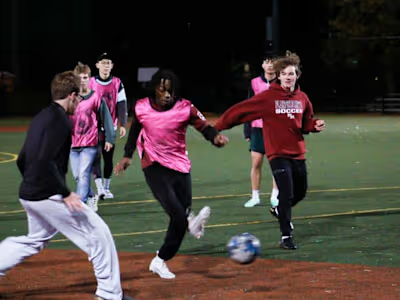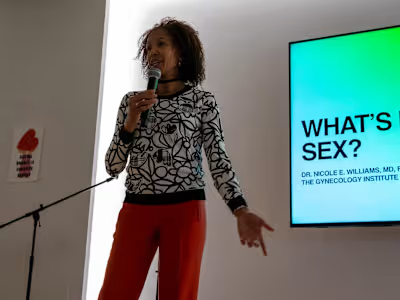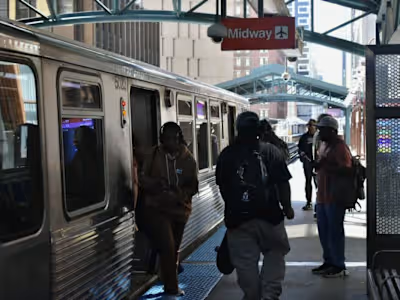Onward Neighborhood House welcomes Chicago's newest arrivals
Onward Neighborhood House welcomes Chicago's newest arrivals
Pages 11-13
By Maya Liquigan
October 16, 2024
A little girl in a bright purple coat huddles between the legs of her family members, who block her from the harsh Chicago wind and rain. On the 5000 block of Diversey Av enue, they are part of a growing line of people, some with all their be longings in metal shop ping carts. Every other Thursday, a line forms outside Onward Neigh borhood House’s food pantry. On this par ticularly rainy Thursday, families are bundled in jackets and wool caps. Some talk to pass the time; others are glued to their phones or silently stare at the passing cars splashing through puddles.
Willie, the first person in line, leans against the windows of the food pantry. He and his wife have relied on the pantry for over a year.
“If it wasn’t for this, we won’t have nothing,” he says.
Lately, he and the others have been joined by a new group needing food: migrants who’ve been bused or flown to Chicago from Texas and who now live in shelters or in the streets—some in the Belmont-Cragin neighborhood, which Onward House serves. They are just one more group in its long history of serving waves of migrants.
Onward Neighborhood House (ONH) began as a church-run settlement house providing immigrants with social services and education in the 1920s. By the 1940s, it became a non profit with a mission “to maintain and conduct an organiza tion to minister to the spiritual, moral, mental and physical needs of the community.” Over the years, it expanded its services, offering a Head Start program funded by the fed eral government in 1965, and a food pantry through partner ship with the Greater Chicago Food Depository in 1979.
In 2008, Onward Neighborhood House moved from West Town, which was no longer a low-income community, to Belmont-Cragin, where the need was greater. To this day, it retains the core features of a settlement house: serving as a community hub and migrant assistance center, which includes providing basic needs like food and clothing as well as educational opportunities for children and adults.
Changing times, changing needs
ONH responds to changing needs as they arise. When the COVID-19 pandemic began, community members were re stricted from receiving healthcare, and many were without insurance. In response, ONH opened a free telehealth pro gram through a partnership with Community Health.
After COVID restrictions were lifted, people wanted to see physicians in person, so the telehealth program evolved over time into a full clinic with exam rooms. ONH worked with Community Health to arrange for physicians to volunteer at the clinic three days a week. This partnership allows ONH to provide care, free of charge for people without insurance. The physicians provide primary care visits, vaccinations, and prescription services.
The pandemic also highlighted the need for adult computer education classes, which ONH began offering along with other adult education classes. Most are taught in Spanish and offered in a hybrid format to accommodate people who work or lack childcare. In April, ONH celebrated 14 students who graduated from their Computer Skills for Business course.
ONH also offers English as a Second Language classes for adults in partnership with Wilbur Wright College, Northwest Community Church and St. Peter’s United Church of Christ. Partnerships like these enable ONH to offer services well be yond what it could with only its own space and staff. Some times, however, ONH isn’t able to sustain all the programs it once offered. The bilingual GED classes provided by Wilbur Wright Community College, for example, have been paused due to a lack of space and resources.
Today, ONH tackles a new challenge with this new wave of immigrants coming to Chicago
The New Arrivals
The most recent number of migrants coming from South and Latin America has increased tremendously since 2022, when Title 42, which suspended entry from designated places to prevent the spread of communicable diseases, ended. Be tween Aug. 31, 2022 and September 17, Gov. Greg Abbott of Texas sent 48,756 asylum-seekers to Chicago by bus and plane, and overwhelmed city services.
Those who find themselves at the ONH Illinois Welcoming Center are greeted by social workers and case managers who provide information and referrals to resources for edu cation, immigration and legal matters, housing, Medicaid ap plications and more. The lobby is often packed with people waiting for a meeting with a case worker. Classrooms have been rearranged to create private rooms for consultation. The center served just over 1,000 people in 2021; in 2023, it served almost five times that number.
Funded by the Illinois Department of Human Services, the Welcoming Center emphasizes the importance of showing hospitality. Staff are trained to connect with new arrivals as humans before treating them as clients: “Being able to bring you into a warm and welcoming environment, especially as you may have just gotten off the bus from Texas after travel ing six months on foot,” says Emilio Araujo, the director of de velopment and communications at ONH. “Being able to have somebody that actually respects [you], listens to you, and wants to see your humanity, I think, is really important. As that’s something that a lot of people have not had in a while.”
One thing that makes Onward more approachable to migrants is that all of the Welcoming Center staff are immigrants them selves. New arrivals can meet with case workers who speak their language and understand their situation and experiences.
Right now, the biggest challenge for ONH is finding stability for its clients: working through the legal processes and housing limitations. Facing complex U.S. policies and a 60 day shelter residency limit, immigrants can’t settle down. They face major issues including finding permanent housing, 12 securing work permits and applying for asylum. Families at ONH also have a lack of access to education and childcare programs.
“How do we help new migrants find stability?” Araujo asks. “To be able to work, make money, to rent an apartment. To do these things that they need to do so they can have that stability and their children can go to school and learn.”
For now, ONH works to provide childcare opportunities to assist parents with daycare needs while they look for work. The bilingual Early Childhood Education at ONH, which is accredited by the National Association for the Education of Young Children and funded by Head Start and Early Start, offers care for children birth to age 5. The bilingual School Age Program supports children ages 5 to 12. Tutors from Glenbrook South High School come to ONH weekly. Both programs are active in the summer and on days Chicago Public Schools are closed.
“For me, education is the underpinning of everything we do here,” says Kimberly Their, director of special education and quality Assurance for ONH. “Whether it’s education directly with our small children, or it's an education for the parents, [it’s] an effort to open up doors, remove the barriers that oth ers don’t have… and provide parents the support that they need, so that they can achieve.”
But government rules and restrictions require parents whose children participate in the Early Childhood Program to be in school or working a minimum of 25 hours per week. This means most of the new arrivals in Chicago are not eligible for the program
ONH is seeking to help parents get jobs or enroll in school through several new, free educational workshops offered through collaborations with the Cicero Family Service and the Binational Institute of Human Development. These work shops cover migrants’ legal rights according to national and local laws, mental health resources, and basics like how to use the CTA. One of the newest workshops provides free asylum and work permit application assistance. But since none of the IWC staff members are lawyers, they can only in form and advise people when filling out asylum applications.
What's next for Onward House
ONH is planning a $7 million grant-funded expansion to ac commodate more clients and provide for the increasing num ber of migrants. The current layout of ONH is split between three buildings and the expansion would be a more cohesive community center in one building.
New plans envision relocating the IWC to the new building; adding exam rooms, a behavioral health specialist room and more lab spaces to the health center; providing more exam rooms for the pediatric clinic; and adding classrooms for the adult education program.
The food pantry would move to the basement of the new building and double its existing space. It would have new walk-in freezers and refrigerators, as well as a waiting area for participants. Willie and the others would no longer have to wait outside for their groceries.
According to the new plans, a rooftop farm would provide the Food Pantry with consistent access to fresh produce and new learning opportunities for the students. At full capacity, it is estimated to be able to grow 2,000 pounds of produce per year.
But there will still be some resources ONH can’t provide. There simply isn’t enough housing to refer newly arrived mi grants to, and Chicago’s 60-day shelter limit still threatens to upend migrants’ lives just as they are settling into their new city.
“I think what’s really challenging for us are the larger scale, more bureaucratic and political issues that we’re facing,” Araujo says. “When new immigrants come and they aren’t able to get a work permit and they’re waiting to submit their asylum information, and their shelter is going to kick them out in 60 days, what’s the solution for that? That’s not something that we can do much about right away.”
Still, they will adapt. “With the expansion, we’re trying to meet the community where they’re at with the demand we’re see ing,” says Joel Stenftenagel, the grant writer at ONH. “We have this 31,000-square-foot building and all these possibili ties on how to use the space. We just decided, ‘Where’s the demand and how can we use this efficiently?’
Like this project
Posted Jan 4, 2025
A little girl in a bright purple coat huddles between the legs of her family members, who block her from the hash Chicago wind and rain. On the 5000 block of...
Likes
0
Views
1





